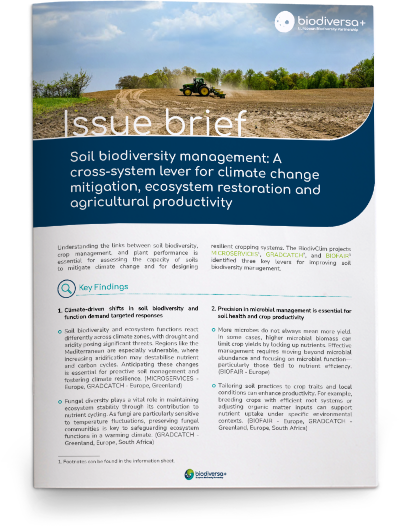Download the issue brief
Issue brief: “Soil biodiversity management: A cross-system lever for climate change mitigation, ecosystem restoration and agricultural productivity”
Soils host some of the most diverse ecosystems on Earth and soil health is increasingly recognised in EU policy, with the Soil Strategy for 2030 and the proposed Soil Monitoring and Resilience Directive. Healthy soils are essential for climate mitigation, food production, and ecosystem restoration, but face growing threats from climate stress and unsustainable farming.
This issue brief brings together insights from three research projects:
- MICROSERVICES, on climate-driven soil biodiversity dynamics
- GRADCATCH, on microbial responses to aridity and warming
- BIOFAIR, on soil biodiversity, crop productivity, and trade-offs
To support both climate mitigation and food security, strategies should focus on microbial functions rather than abundance, be tailored to local agroclimatic and ecological conditions, and integrate soil biodiversity into mainstream restoration and agricultural planning.
Main findings
- Climate-driven changes in soil life call for targeted responses. Soil biodiversity and its functions respond differently to climate change across regions. Arid and drought-prone areas, such as the Mediterranean, are particularly vulnerable to disruptions in nutrient and carbon cycles. Fungal diversity plays a key role in ecosystem stability but is highly sensitive to temperature shifts, making its conservation a priority for maintaining soil functions.
- Precision in microbial management is essential for soil health and crop performance. More microbes do not always mean better outcomes. In some cases, high microbial biomass can compete with crops for nutrients, reducing yields. Management should focus on enhancing microbial function rather than abundance, tailoring practices like organic matter inputs to crop traits and local conditions.
- Balancing biodiversity, productivity, and farming realities is crucial. There are trade-offs between practices that support soil biodiversity and those that maximise yields. For example, reduced tillage may benefit microbial communities but lower wheat yields in some settings. Similarly, increasing soil carbon does not always boost productivity. This underscores the need for context-specific soil management adapted to local systems and environments.
